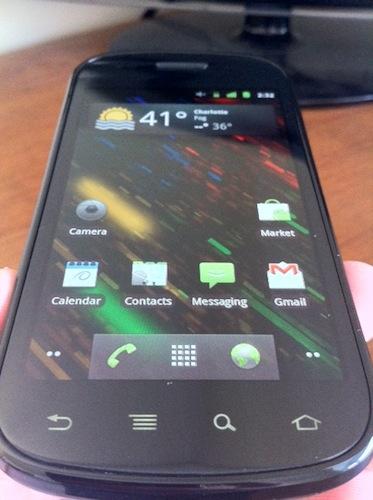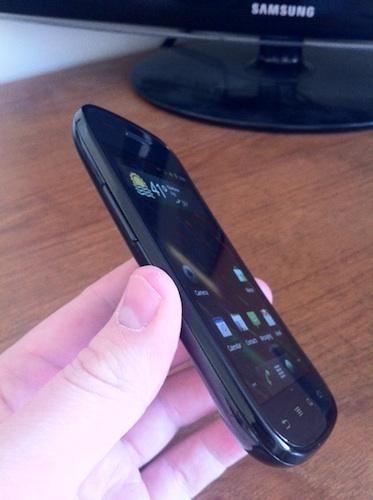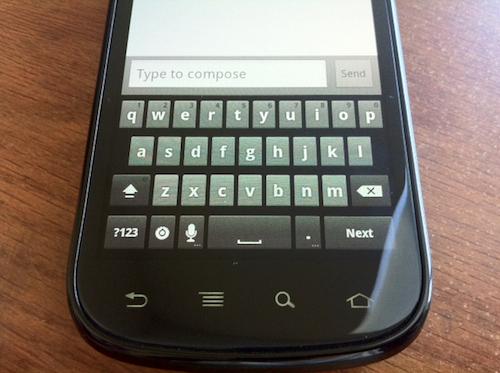
Fast forward to today, and Android phones are scattered across the four nationwide carriers. 1 GHz processors are commonplace, and high-resolution displays are expected on the flagship devices. Google's second device, the Samsung Nexus S, offers a 1 GHz Hummingbird processor, 4-inch Super AMOLED display, 5-megapixel camera, front-facing camera, and Android 2.3, the latest version of the popular operating system. The Nexus S is well-equipped in the specifications department, but in a sea of high-end Android devices, does it distinguish itself?

The left spine contains the volume rocker, while the right spine houses the power button. The 3.5mm headphone jack and micro USB charging port are on the bottom, and the 5-megapixel camera is located on the back. In the box, you get an AC adapter module, USB cable, stereo earbuds, and the instruction manuals.
The Nexus S offers a 4-inch Super AMOLED display, and it's absolutely gorgeous. Colors pop, and it rivals the other competing high-resolution displays on the market. The external plastic protecting the screen is curved, making it easy to hold for a long call. Like the Samsung Galaxy S series, the Nexus S' plastic build quality will be a love or hate thing, depending on personal preference. On one hand, it's constructed well (despite the plastic) and is lightweight. On the other hand, the phone is bland and isn't as aesthetically pleasing as devices like the Apple iPhone 4, HTC Desire HD, or T-Mobile G2.
The Nexus S ships with a stock version of Android 2.3 ("Gingerbread"), the newest version of Android. For the most part, Gingerbread's improvements over Android 2.2 (Froyo) are cosmetic. The color theme has changed from light grey to dark grey, the signal strength indicator area has been tweaked, and the Phone application sports some minor improvements. The Nexus S supports NFC (near field communication), so it can read things like the "Recommended on Google" stickers you see at select stores. Google was kind enough to send one over with the review unit, and the Nexus S detected it with ease.

Android 2.3 includes a new "Android keyboard," and while it's clearly personal preference, I didn't care for the revised QWERTY. The keys are shorter and fatter than the original Android keyboard, and for someone with large hands, it's a challenge to use. Fortunately, there are keyboard alternatives in the Android Market, and I found myself reverting to them throughout testing.
The phone offers a 5-megapixel camera with a flash, and as with the Samsung Galaxy S line, picture quality is absolutely fantastic. My only complaint is the lack of a physical camera button. The button on the touchscreen works well enough, but can present a challenge for those that have shaky hands. The Nexus S also offers a VGA front-facing camera for video calling, and as you would expect, image quality is grainy. While the phone shoots video, it does so in 480p, not in the 720p HD resolution that's typical of a high-end device. It's widely expected that a future software update will rectify the issue, but for a "Google Experience" device, the lack of a common feature such as HD video recording is surprising.
I tested the Google Nexus S in the Charlotte metro area, and call quality was very good. The software-based noise cancellation seemed to work well, as callers reported little to no background noise, even in loud environments. I tested the earpiece in a loud coffee shop, gas station, and with my windows down, and callers were able to understand me without major issue. One caller told me that they couldn't tell whether I was calling from a cell phone or a landline. The speakerphone works well, and when I tested it in another busy coffee shop in the area, callers were able to hear me (though they reported some background noise).
The Nexus S ships with a 1,500 mAh battery, and it's one of the better Android devices on the market when it comes to battery life. With moderate use including calling, text messaging, browsing the web, use of widgets, and downloading apps in the Android Market, I was able to make it through the day before the low battery warning indicator flashed. The downside? Like the Galaxy S series, the Nexus S takes much longer to charge. Those that charge every evening should be fine, but for those (like me) that forget, you'll be hard pressed to find the spare few hours that are required to charge it from zero to 100 percent.
Since the Nexus S is an HSPA-capable device, it doesn't take advantage of T-Mobile's new "4G" (HSPA+) network. Oddly enough, overall network speeds were as fast or faster than HSPA+ in the Charlotte market. In several tests, I obtained download speeds between 2 and 4.5 Mbps, and upload speeds between 1.5 and 2.5 Mbps.
Like the Nexus One, the Google Nexus S is the ultimate device for Android die-hards. Though not as ahead of the curve as the Nexus One was when it launched, the 1 GHz processor, 4-inch Super AMOLED display, and Android 2.3 make it a viable smartphone option for many. That said, the stock build of Android continues to be rough around the edges, so first-time T-Mobile smartphone buyers or those that want a more aesthetically pleasing build of Android will be happier with devices like the T-Mobile myTouch 4G and Samsung Vibrant.
What's Good: Absolutely beautiful display; front-facing camera for video calling; offers the latest version of Android (2.3).
What's Bad: Plastic build quality may turn off prospective buyers; battery takes too long to charge.
The Verdict: The Google Nexus S is a feature-packed, high-end "Google Experience" phone that should please many. That said, it's not as far ahead of the curve as the Nexus One was when it launched.
The Google Nexus S is available exclusively from Best Buy Mobile for $199.99 with a new two-year agreement, $249.99 with a two-year renewal, and $529.99 full retail. For more, be sure to check out our complete Nexus S coverage!